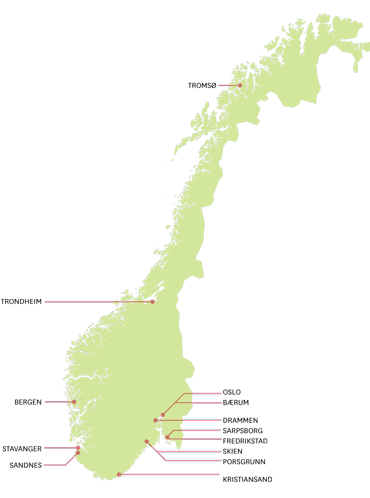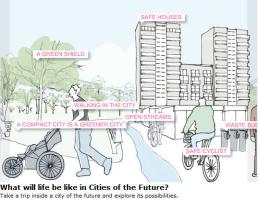Also discussed here: Cities of the Future: From Norway with love (World Streets, Dec. 6. 2012)
And here: Cities of the Future 2008–2014 - Agreement between the state, KS and the municipalities (3 page pdf, Government of Norway)
 Today we look at the cities of the future in northern Scandinavia where 13 of Norway’s largest cities have become engaged with their national government in a 6 year program, ending in 2014 “to reduce greenhouse gas emissions and make the cities better places to live”. The initiatives are broken down into four distinct categories (Land Use and Transport, Consumption and Waste, Energy and Buildings, and Climate Adaptation) and each of these has several sub components with specific examples of progress being made. This would be of special interest to other northern countries, such as Canada and Russia, where carbon fuels needed in winter for heating buildings and for transportation and where introducing new energy sources and infrastructure to reduce emissions are big challenges. Some, if not all, of the ideas may be borrowed and used elsewhere in the wake of the recent 2012 Conference of the Parties (COP) 18 at Doha, Qatar where the world and the world’s cities in particular look ahead to post-Kyoto years as to how to reduce global emissions by the 90% required in the short time available.
Today we look at the cities of the future in northern Scandinavia where 13 of Norway’s largest cities have become engaged with their national government in a 6 year program, ending in 2014 “to reduce greenhouse gas emissions and make the cities better places to live”. The initiatives are broken down into four distinct categories (Land Use and Transport, Consumption and Waste, Energy and Buildings, and Climate Adaptation) and each of these has several sub components with specific examples of progress being made. This would be of special interest to other northern countries, such as Canada and Russia, where carbon fuels needed in winter for heating buildings and for transportation and where introducing new energy sources and infrastructure to reduce emissions are big challenges. Some, if not all, of the ideas may be borrowed and used elsewhere in the wake of the recent 2012 Conference of the Parties (COP) 18 at Doha, Qatar where the world and the world’s cities in particular look ahead to post-Kyoto years as to how to reduce global emissions by the 90% required in the short time available.

Key Quotes:
“Cities of the Future is a collaboration between the Government and the 13 largest cities in Norway to reduce greenhouse gas emissions and make the cities better places to live… are densely built. This means we can walk and cycle instead of using cars, reducing pollution. Fewer cars and roads make more room for bike paths and parks. This makes the cities prettier and makes us healthier.”
Some key elements of the program:
1. Land Use and Transport “Public Transport - Today 30% of all car journeys are less than 3 km. If the alternatives are good enough, we can easily replace the car on these journeys. Land Use - In the USA many cities have no functional centre, and the motorway for a shopping street. We want to plan the cities so we can walk and cycle to our destinations, and create a functional city centre.Footpaths and Cycle Paths - A city in which the inhabitants can walk or cycle to work every day has lower greenhouse gas emissions, better air, a better city centre and healthier inhabitants. Parking - If we limit the parking in the city centre, we also limit car traffic. Car Use - We can develop public transport and cycle paths to make people leave their car at home; but this will not work until there are restrictions on car use. Only then will queues be shorter and emissions lower.”
2. Consumption and Waste “Waste Treatment and Recycling - Waste can be a source of valuable energy. This will reduce both waste and emissions. Waste Prevention - Support for composting, charges on disposable packaging, VAT-exemptions on repairs; using simple measures we can reduce the amount of waste and greenhouse gas emissions. Consumption Pattern - Everything we buy and use affects the climate. This gives us power to influence both the business sector and politicians to act more environmentally friendly. Procurement - The municipalities do not just save money when making green purchases. They also create a bigger market for green products, whether these are travels, paper or energy. Green Management - Paper free City Councils or buying emission quotas for air travels – green management in the municipalities can play an important role in the reduction of greenhouse gas emissions.”
3. Energy and Buildings “Energy Use - The municipalities are responsible for 1/3 of energy consumption in Norwegian office buildings. This gives them a great opportunity to reduce the country’s energy consumption, and save money. Energy Sources - We get our energy from the wind, the sun and the sea – or from the waste the inhabitants produce. Energy Supply - With a compact city structure it is easier to connect more people to the distance heating plant, made for renewable energy sources. Information and Competence - We use energy nearly all the time. This means a lot can be gained from what appears to be simple measures. As long as we know what really works.”
4. Climate Change Adaptation “Precipitation - There will be more and heavier rain in the future. We need to strengthen the cities, both under and above ground to secure our welfare. This will make the cities better to live in. Flood - If we use too much tarmac and cover up too many streams in our cities, there is nowhere for the rainwater to go. However, this also means that damage can be prevented – as long as the city is built the right way. Landslides - More rain and snow increase the landslide hazard where people live. Landslide hazard mapping enables us to secure safe locations for new housing and infrastructure. Sea Level - Researchers predict that the sea level will have risen 40 cm by the end of this century. We have to build cities that can stand a higher sea level, and maybe we can enjoy it too. Wind - Strong winds give us more energy, but can also cause great damage if we do not develop our cities to prevent it.”









No comments:
Post a Comment